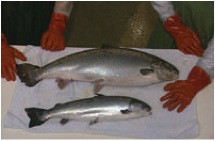The seemingly straightforward question, “What are we having for dinner?” may get trickier to answer, due to a revolution in science. Many people call it “frankenfood” when the answer to the dinner question could be, “Salmon with a dash of eel genes”!
This genetic manipulation isn’t some pie-in-the-sky notion. In December, the US Food and Drug Administration moved one step closer to approving Massachusetts-based AquaBounty’s application to sell genetically modified (GM) salmon. The agency found the company’s AquAdvantage GM salmon is safe for human consumption and does not pose a significant risk to the environment. Yet both AquaBounty’s product and numerous other GMO foods have raised serious concerns from many different groups.
Technology is moving so far ahead of common understanding that the language of “trans-genes” is not yet in our vocabulary, but it should be. If you ask most Canadians what genetic engineering (GE), or genetic modification mean, most people don’t even understand the question, let alone have an answer.
As a primer for anyone who is bewildered by the idea of designer plants and animals, genetic modification is a technology that scientists use to bring genetic information from different species together in unnatural combinations. Think of it as a Rubik’s cube where you can twist in genes from unrelated species, adding spider genes to a goat, or genes from bacteria and viruses into corn.
Despite the general lack of knowledge about genetically modified organisms (GMO) our Federal government is promoting transgenic technologies using taxpayers’ money. As recently as January 2010, AquaBounty was given $2.9 million for research purposes. The company wants to produce all the GM salmon eggs on Prince Edward Island, and then ship the eggs to Panama for growing-out and processing, for export to North America as “table-ready” fish.
What is the difference between genetically modified (GMO) salmon and natural salmon? AquaBounty’s gene-altered salmon are artificially given genes from an eel-like creature called ocean pout and genes from Chinook salmon.
These salmon have been genetically re-structured to produce growth hormones throughout the year and therefore grow unnaturally quickly. The gene-altered salmon are also nutritionally inferior to wild Atlantic salmon. According to data supplied by AquaBounty, gene-modified salmon contain less beneficial omega-3 fatty acids than other farmed salmon.
Of major concern about gene-altered salmon is escape and harm to wild salmon populations. What would happen if GE fish were to escape into the wild? The biotech company created the fish to be sterile, but admits that 5% could be fertile. I wonder whose job it will be to determine if fish are fertile?! Wild Atlantic salmon stock could be cross-contaminated and the already endangered natural species could be severely affected.
Another major issue is the health risks to humans who would eat this product. The health data supplied by the company has been summarized as “sloppy science, with woefully inadequate data, small sample sizes, and questionable practices”, according to Senior Scientist Dr. Michael Hansen of the Consumers Union.
AquaBounty’s research includes testing seemingly designed to obscure potential problems rather than reveal them. Take for instance the sample sizes. Common sense would tell you that when studying something as revolutionary as the world’s first GMO fish, which steadily pumps out growth hormones, that studies must be very broad and rigorous. Yet the actual sample size of the study to test for changes in morphology of the salmon involved only 12 fish.
Data published in the British newspaper, the Guardian, revealed that the AquaBounty salmon had an elevated level of insulin-like growth factor-1 (IGF-1), which is a hormone linked to a number of cancers. The FDA, which is also in the process of approving this ‘animal-drug’ (as it is classified), dismissed the fact that there was a high rate of physical deformity among the modified salmon.
Another disturbing fact is that government officials in the US and Canada have not asked the company for data from long-term feeding trials. Without this testing, the public has no way of knowing if this modified salmon is safe to eat. Does that leave humans as the actual test animals? If approved, will the fish be labeled as being genetically modified? Currently there is no mandatory labeling of genetically modified foods in North America.
In the USA, over 300 environmental, consumer, health and animal welfare organizations, including salmon and fishing groups and associations, chefs and restaurants signed joint letters to the FDA requesting that the approval be denied.
Even the farmed fish industry is in opposition. The executive director of the Canadian Aquaculture Industry Alliance told CBC, “The Canadian aquaculture industry does not support the commercial production of transgenic fish for human consumption.”
In North America, people are still largely unaware of any threat to the wild natural Atlantic salmon. Those who are aware have planned demonstrations, are writing letters to the editor, talking to their government officials and telling their fish suppliers that they will stop eating salmon entirely if modified salmon goes to market and is unlabeled.
Consumers are not demanding designer fish, nor did they ask for the taxpayers’ money to be used to re-create plants and animals into patented name brands. Citizens content with the natural plants and animals are increasingly disturbed that public involvement has been entirely bypassed on a subject as important as the future of the food supply.
The FDA is now accepting public comments on AqauBounty’s application until February 25, 2013, after which it will render its decision of whether or not to approve the production and sale of this GM fish.
Take action on AquaBounty’s applications through:
Heidi Osterman is a Kelowna-based certified nutritionist and President of the True Food Foundation.



3 comments (Archive) add comments
Wednesday, 06 February 2013 14:50 posted by Kim
Thank you. I have written the Ministers involved.
The health implications could be catastrophic, for marine life and humans! Would it trigger human growth hormone in humans? Cancer growth? Allergies?
Wednesday, 06 February 2013 12:58 posted by Rod Marining
GMO fish should not enter the Wild fish eco-system. Virus and diseases are transfered between species. Sea Lice love feedlots to breed incessently. Please keep experimental feedlot fish out of the natural environment. We here on the West Coast have watch the Wild Salmon degrade in population, due to the introduction of Salmon Feed lots with exposure to the ocean environment. Rod Marining Biologist.
Wednesday, 06 February 2013 08:53 posted by Len
They told us when atlantic salmon were brought to the west coast that they were sterile too….and we know for a fact that was BULL SH#T….thats what fishfarmers are best at